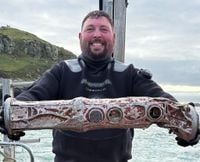Volunteer divers off the west coast of Wales recently stumbled upon a discovery that has sent ripples through the security and maritime communities in the United Kingdom and beyond. On November 15, 2025, members of Neptune’s Army of Rubbish Cleaners (NARC)—a group better known for clearing up ghost fishing gear and discarded shopping trolleys—found what defense analysts now believe is a Russian RGB-1A sonobuoy, a hydroacoustic device designed to track submarines. The find, made in the Skomer Marine Conservation Zone near Wooltack Point, Pembrokeshire, has reignited concerns about Russian surveillance activity in British waters, especially as it comes amid a spate of similar discoveries across Europe in recent years.
The story began innocuously enough. The NARC team, led by chairman Dave Kennard, was wrapping up its final clean-up weekend of the season. Volunteer diver Tim Smith-Gosling spotted a large, battered cylindrical object wedged in a rocky gulley. At first, the team assumed it was a navigation marker, but a closer look raised suspicions. The device, measuring about 120 centimeters (roughly 4 feet) in length and weighing around 15 kilograms (33 pounds), bore a striking resemblance to military acoustic equipment. "We became suspicious after comparing the object to previously recovered finds in Cornwall and Ireland," Kennard told the BBC.
After lifting the device to the surface with a dive bag, the NARC team did what protocol demands: they consulted port authority officials and reported the find to HM Coastguard. The Maritime and Coastguard Agency confirmed the report had been logged on November 19, 2025, but stated, "No one was reported to be in danger or in difficulty and the communication was recorded, without requiring a search and rescue response." The battered device was handed over to the authorities for further analysis.
Defense experts quickly weighed in. An independent analyst told the BBC he was "confident" the object was a Russian RGB-1A sonobuoy, typically dropped by the long-range Tupolev Tu-142M maritime patrol aircraft. The expert pointed to the device’s three vertically aligned hydrophones and signs of deep-water implosion as diagnostic features. Dr. Andy Scollick, a strategic defense consultant, agreed, describing it as a "Russian hydroacoustic buoy of type RGB, probably RGB-1," and noting that the missing serial number sleeve made precise identification more challenging. The relatively clean condition of the device, with little marine growth, suggested it had been deployed not long ago.
Sonobuoys like the RGB-1A are sophisticated pieces of military hardware. They contain a radio transmitter for use while afloat and hydrophone sensors for underwater detection, making them valuable tools for anti-submarine warfare and acoustic research. First used during World War II, these devices are now routinely deployed during naval exercises and operations. But their presence in British waters—especially when found by civilian divers rather than military patrols—raises pointed questions about foreign intelligence-gathering activities in the UK’s maritime backyard.
This isn’t the first time such a discovery has been made. According to BBC analysts, similar devices have washed up on beaches in Cornwall and Ireland in 2021, and even as far afield as Lithuania in 2024. In some cases, devices have been found in Russia’s own Novosibirsk region. The pattern is clear: Russian hydroacoustic buoys are being deployed across European waters, and some are ending up far from their intended drop zones.
The timing of the Welsh discovery is particularly notable. Just days after the NARC divers found the sonobuoy, the Russian spy ship Yantar was caught operating near the edge of the UK’s 12-mile territorial limit. According to BBC and other sources, Yantar responded to being tracked by RAF patrol aircraft by aiming lasers at the pilots—a move that’s widely seen as both a provocation and a warning. The ship has long been suspected of mapping undersea cables, which carry over 90% of Britain’s internet traffic and billions in financial data. In April 2025, Russian sensors believed to be spying on nuclear submarines were also found in seas around the UK after washing ashore, further fueling concerns about ongoing surveillance efforts.
Security officials have been careful in their public statements. The Royal Navy, when approached for comment by the BBC, declined to address the specific discovery, citing operational security. A spokesperson explained, "We do not comment on specific underwater activities or individual finds due to operational security considerations." However, the Navy did emphasize that Britain "continually monitors UK waters and works closely with allied militaries to track foreign underwater activity." This stance is echoed by the Maritime and Coastguard Agency, which confirmed that the recent report was handled according to established procedures.
Behind the scenes, though, the discovery has sparked renewed debate about maritime security and the challenges of monitoring the vast expanse of the UK’s coastal waters. The fact that a group of volunteer divers—not military professionals—made the find highlights the difficulty of detecting and recovering such devices. It also underscores the importance of civilian vigilance and cooperation with authorities. Divers are routinely warned not to touch or move suspected sonobuoys, as they can contain hazardous materials, but to report them to the Coastguard immediately.
The broader geopolitical context can’t be ignored. Tensions between Russia and the West have intensified in recent years, with the seas around the UK becoming a focal point for intelligence gathering and counter-surveillance. Earlier in November 2025, the Royal Navy intercepted two Russian naval vessels moving along Britain’s coastline, with HMS Severn shadowing the corvette Stoikiy and the tanker Elnya for nearly two weeks as they transited the Dover Strait and continued west into the Channel. These incidents, along with the discovery of the RGB-1A sonobuoy, paint a picture of a maritime environment where the lines between routine operations and strategic maneuvering are increasingly blurred.
For the NARC divers, the experience has been a reminder that even routine clean-up dives can yield the unexpected. As Dave Kennard reflected, the team was able to identify the object only after drawing on their collective experience and consulting with experts. Their story, covered by the BBC and other outlets, has brought renewed attention to the hidden world of underwater surveillance and the ongoing cat-and-mouse game beneath the waves.
As Britain and its allies continue to monitor their waters, the discovery off Wales is a stark illustration of the challenges posed by modern maritime espionage. It also serves as a testament to the crucial role played by vigilant citizens—and a reminder that sometimes, the most significant finds are made by those simply trying to clean up the sea.





